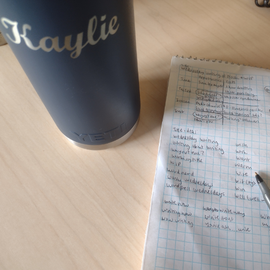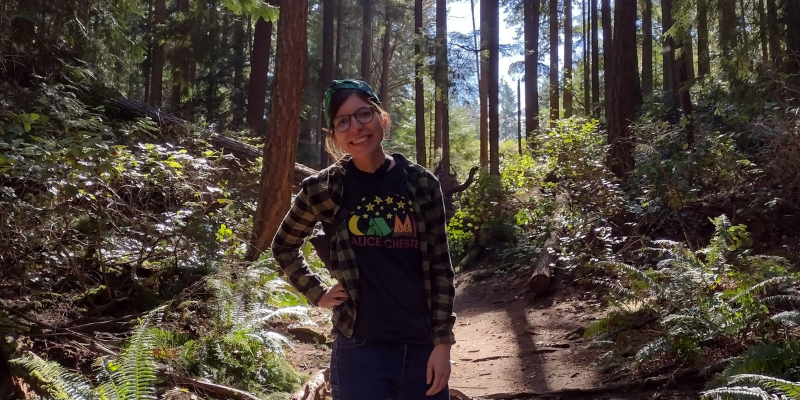After a month of writing about some amazing friends and family via my Womxn in Progress series, I am now sharing MY own work every Wednesday this month, in a new web series tentatively called “Why Wait?”. To start, last Wednesday, April 6th, I rewrote the work webpage of my website. I even posted about it on my public Instagram profile and largely private Facebook profile. Even though I’ve had this website since 2019, I seldom share my work via my social channels.
While I am delighted to be finally getting paid for freelance editing, learning to model, and am also writing professionally (all while working full-time as the marketing manager for a not-for-profit, independent school), I was too nervous to socially share one of my biggest projects: I am drafting a book! I am writing a book about the opportunity cost of behavior change.
I’ve blogged on and off for over 3 years, sharing how my goals and habits influence my sense of self and society. My book’s topic may come as no surprise. Or, if this theme sounds like jargon to you, no sweat. Let’s break down those words, all by asking questions. In so doing, I’ll show why this topic matters so much to me. You, dear reader, may learn about me, too.
What is opportunity cost?
I’ve written extensively about this, but my current definition of opportunity cost is that in each decision, there’s a chance for gains AND losses. In other words, opportunity cost is the ultimate way to represent the pros and cons of any choice. I LOVE making lists, and by pairing opportunities AND costs together, I can see my thoughts, feelings, and tools all in one place, ultimately helping me make a decision.
Here’s a non-extensive list of my articles on opportunity cost and behaviors, including one from when my website was just a few months old!
- 2022: Grace and relationships, responsibilities, and releasing and Grace and growth, guilt, and goals
- 2021: Write do and don’t do lists, Opportunity cost of taking a break, Record and repeat your habits, and Opportunity cost of habit change
- 2020: Surrounding smaller habits for bigger goals
- 2019: How do you maintain a habit?
- More articles: Use the search function, explore the “WIP: Goals in Progress” category, or take a look at my annual list of goals
How am I applying opportunity cost to behavior change(s) in this book?
The book will look at community and cultural practices. Ever curious, I have some intense psychological and sociological inquiries. How do individuals make changes for themselves? How do individuals influence communities? Are there entire cultures dependent on change? Consider this, in practically every movement, there’s multiple cultures and countercultures, so do any communities support “sustainable shifting” of practices?
If you’ve followed my website for a while, you know I personally make life changes via habits and goals. Most of the book will focus on how individuals make shifts. I use opportunity/cost list-making to understand my own beliefs, but they can also help me see how to participate in cultural movements, too.
For example, I call myself a “work in progress minimalist”, especially for digital minimalism. I am still learning to single-task, such as minimizing daily computer tabs. Yet other branches of minimalism are easier for me, such as choosing a closet full of pre-matched outfits. The book will discuss both the self and the society when working to change, acknowledging that habits and norms take effort, and (usually) a ton of resources.
What do you need to START crafting an opportunity/cost list?
The book is all about taking ownership of your life, so the key thing readers need going in is the WANT to make a change, whether it’s “big” or “small.” As I’ve written in the past, I’ve learned to take agency over my life’s developments. Some shifts were intentional, others less so.
The main way I’ve consciously worked to change my life is by outlining opportunities and costs for each idea. My book will give literal space for these opportunity/cost lists, through graph or dotted paper on the side of each page of the book. This practice of list or chart-making has the potential to inspire readers to live richly, driven by their own unique goals and habits… including the removal of some habits that aren’t serving.
Besides this want for change, as well as paper WITHIN the book itself to actually create these lists and charts, readers need to give themselves time. Time is the biggest resource of all. This includes time to reflect on current habits, and then time to practice new ones. Some strategies I’m considering are of course opportunity/cost lists, habit stacking and tracking, and intentional abstinence. The book’s tools are not and will not be “one and done” solutions. I am neither a doctor nor a millionaire, and I absolutely do not have all the answers. But I have found some nearly universal tools needed to make behavior changes.

What are these resources or tools needed in MAKING or SUSTAINING changes?
In each decision, you must choose if a change is “worth it.” What are you really seeking? You’re asking for tools in helping decide what to do, keep working on, or even STOP doing. The key decision-making tools of the book are acknowledging the costs and opportunities of time, talents, treasures, and trust. And that’s why the name of the game book (at least right now) is the opportunity cost of behavior change.
These tools of time, talents, treasures, and trust are often earned with practice. But these resources are not just within yourself. Certainly, there is a lot of work in making a change reality. Hence, if you have a goal, it’ll take time, cultivation of skills, and generally funding. But change also takes guts.
That’s why TRUST, such as in the self and in one’s society, is a resource. Because when you have given energy (time, talents, treasures) to a new goal, you still need to trust yourself and/or the universe, too. This isn’t woo-woo, it’s the heart of it. Humans are not just bodies; we carry feelings, thoughts, intuitions. So even if you start by not believing in yourself, maybe by the end of the book (or even this blog post), you may begin your journey.
Are there communities or cultures that influence individual behavior changes?
We are not mere products of our thoughts and feelings; environments can push behavior changes, too. I’ve found certain communities inspire change, such as minimalists, gym rats, vegans, Lent practicers, and New Year’s Resolutioners. I may dive into how these groups omit and commit to certain practices. Are they sustainable? How, why do individuals gravitate to these groups? What about the outgroups? How are group leaders influenced in making behavior changes or are they more stagnant/stable in their habits? Ultimately, my hope is that the book will help you understand when to sustain, maintain, and refrain from choices and changes.
If you’d like to participate in the book’s content, please consider filling out this form, all about behavior changes via goal setting. I will contact you for follow-up, but you can also leave your answers anonymous. All questions are optional, but consider this: my goal is to turn this book into a multimedia experience. I’d love to include social media tools to inspire engagement, as well as potentially interview people via podcast. Ultimately, I need ample participation in the hope of discovering more patterns.
Consider commenting here and/or filling out the form if you have refrained from or participated in cultural practices (ie, vegans choosing to not eat meat), if you’re chosen to omit or break a habit (ie, giving up something for Lent), and/or if you have feelings about goals (ie, you’re not a big fan of New Year’s Resolutions or LOVE them). If you prefer anonymity but still would like to answer, that’s an option too. Personally? You are what you give energy to, so I will be writing about the book every Wednesday on this website. Whether you read, comment, share this post, or fill out the form, thank you for helping make my book a reality.


2 thoughts on “Introducing: Why Wait? A Weekly Writing Series”